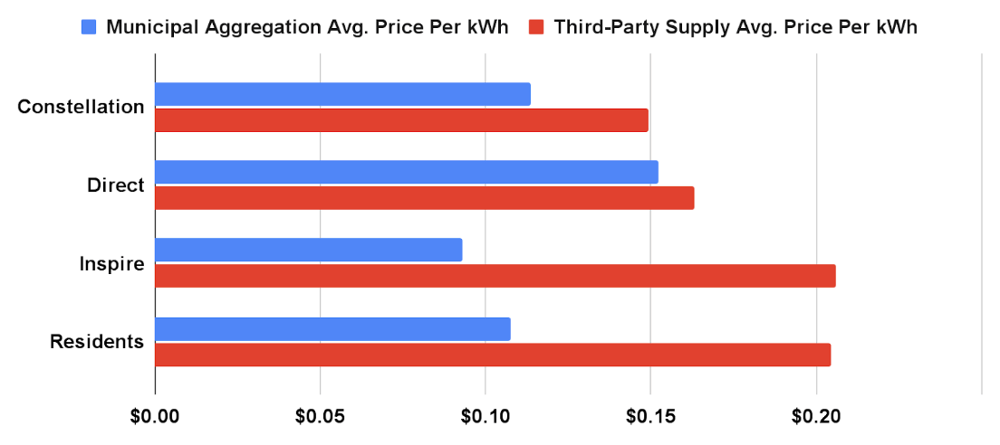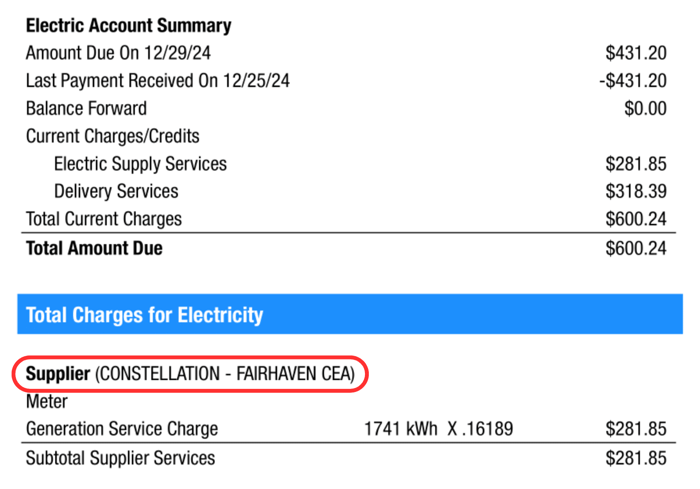Municipal Aggregation Keeps on Winning: Greener Power at Lowest Cost
From time to time, we report on how municipal aggregation is going in Massachusetts – and soon, Rhode Island. It’s...
In Massachusetts, third-party electric suppliers, also called “competitive suppliers”, are allowed to sell electricity directly to residential customers of Eversource, National Grid, and Unitil (although the cost of delivering the power is always charged by the local utility). While the idea behind allowing these companies to operate was that they would increase competition and bring down electric prices, this is not how things have worked in practice.
Statewide in 2023, the average third-party supplier charged 19.8 cents per kilowatt-hour (kWh) of power sold, 3 cents more than the average default electric supplier. A default supplier is the organization that sells electricity by default to residential customers in an area. Default suppliers are municipal aggregation programs in municipalities that have them and utilities in towns that do not.
The high prices charged by third-party suppliers resulted in residential consumers paying an estimated $91.7 million dollars more for electricity in 2023 than they would have had all residential customers stayed with their default supplier. This means that rather than decreasing electricity prices, the ability of third-party suppliers to sell directly to residential customers resulted in increased electric rates. Note that our analysis is aligned with that of the Mass. Attorney General's Office, which found that residential consumers who chose their own retail supplier between July 2023 and June 2024 paid $73 million more than if they bought power supply from their utility.
As can be seen in the chart below, the vast majority of third-party suppliers’ average price per kilowatt-hour of electricity (kWh) was above the average default supplier price and significantly above the average municipal aggregation price.

A company-level breakdown of third-party suppliers' sales and costs in 2023 can be seen here:
|
Supplier |
Average Cost Per kWh |
Difference from the Average Default Rate |
Total Ratepayer Savings |
Percent of Ratepayer Overcharging |
Megawatt Hours (MWh) Sold |
|
Summer Energy Northeast, LLC |
$0.4677 |
$0.2993 |
-$560,914 |
0.5% |
1,874 |
|
Mega Energy of New England, LLC |
$0.3732 |
$0.2048 |
-$71,083 |
0.1% |
347 |
|
American Power & Gas |
$0.3400 |
$0.1717 |
-$1,717 |
0.0% |
10 |
|
Public Power LLC (CT) |
$0.3251 |
$0.1568 |
-$721,195 |
0.7% |
4,600 |
|
Atlantic Energy LLC |
$0.3141 |
$0.1458 |
-$4,858,322 |
4.6% |
33,333 |
|
CleanChoice Energy, Inc. |
$0.3026 |
$0.1342 |
-$22,928,116 |
21.7% |
170,823 |
|
Verde Energy USA |
$0.3017 |
$0.1334 |
-$4,367,738 |
4.1% |
32,749 |
|
Discount Power Inc - (CT) |
$0.2811 |
$0.1127 |
-$3,783,797 |
3.6% |
33,566 |
|
Palmco Power MA, LLC |
$0.2751 |
$0.1068 |
-$2,612,668 |
2.5% |
24,469 |
|
Provider Power MASS, LLC |
$0.2619 |
$0.0935 |
-$6,938,166 |
6.6% |
74,202 |
|
National Gas & Electric, LLC |
$0.2512 |
$0.0828 |
-$3,343,872 |
3.2% |
40,377 |
|
SmartEnergy Holdings, LLC |
$0.2357 |
$0.0674 |
-$5,020,377 |
4.8% |
74,493 |
|
Major Energy Electric Services |
$0.2260 |
$0.0577 |
-$1,774,227 |
1.7% |
30,774 |
|
Viridian Energy LLC |
$0.2211 |
$0.0527 |
-$3,258,385 |
3.1% |
61,827 |
|
Reliant Energy Northeast LLC |
$0.2185 |
$0.0502 |
-$13,204,193 |
12.5% |
263,208 |
|
Ambit Energy Holdings, LLC |
$0.2149 |
$0.0465 |
-$2,473,463 |
2.3% |
53,182 |
|
Green Mountain Energy Company |
$0.2142 |
$0.0458 |
-$484,056 |
0.5% |
10,567 |
|
Inspire Energy Holdings, LLC |
$0.2059 |
$0.0375 |
-$16,763,182 |
15.9% |
446,911 |
|
Nordic Energy Services, LLC |
$0.2053 |
$0.0370 |
-$1,037,327 |
1.0% |
28,060 |
|
Residents Energy, LLC |
$0.2044 |
$0.0360 |
-$4,147,154 |
3.9% |
115,088 |
|
Everyday Energy LLC |
$0.2030 |
$0.0347 |
-$11,540 |
0.0% |
333 |
|
Energy Services Providers, Inc |
$0.2026 |
$0.0343 |
-$143,744 |
0.1% |
4,194 |
|
Energy Plus Holdings LLC |
$0.2015 |
$0.0331 |
-$282,018 |
0.3% |
8,509 |
|
Clearview Electric Inc. |
$0.2012 |
$0.0328 |
-$3,594,509 |
3.4% |
109,564 |
|
Energywell LLC |
$0.1987 |
$0.0304 |
-$841,247 |
0.8% |
27,691 |
|
XOOM Energy Massachusetts, LLC |
$0.1973 |
$0.0290 |
-$874,207 |
0.8% |
30,192 |
|
SFE Energy Massachusetts, Inc. |
$0.1972 |
$0.0288 |
-$1,143,515 |
1.1% |
39,658 |
|
Alpha Gas and Electric, LLC |
$0.1941 |
$0.0258 |
-$276,294 |
0.3% |
10,723 |
|
Renaissance Power & Gas, Inc. |
$0.1760 |
$0.0076 |
-$156,503 |
0.1% |
20,565 |
|
Town Square Energy |
$0.1601 |
-$0.0082 |
$909,994 |
N/A |
110,338 |
|
Titan Gas LLC |
$0.1546 |
-$0.0137 |
$1,124,154 |
N/A |
81,803 |
|
Direct Energy Services |
$0.163 |
-$0.0052 |
$3,538,229 |
N/A |
675,601 |
|
Constellation NewEnergy, Inc |
$0.1492 |
-$0.0192 |
$8,304,108 |
N/A |
433,079 |
|
Eligo Energy, LLC |
$0.1408 |
-$0.0276 |
$7,633 |
N/A |
277 |
|
Just Energy |
$0.1335 |
-$0.0348 |
$39,334 |
N/A |
1,130 |
|
MidAmerican Energy Services, LLC |
$0.1321 |
-$0.0362 |
$11,955 |
N/A |
330 |
|
Astral Energy LLC |
$0.1061 |
-$0.0623 |
$2,056 |
N/A |
33 |
|
Total |
|
|
-$91,736,064 |
|
3,054,479 |
See the methodology sections for sources.
One thing to note is the figures listed above are only suppliers’ average cost per kWh in 2023. The suppliers' relative prices could have changed since then. Further, just because a supplier has a low average price does not mean that every product that the company offers is a good deal for the customer.
Even beyond price, there are two main reasons that our organization does not recommend signing contracts with third-party electric suppliers.
One is that, as we’ve written about before, consumer complaints to the Mass. Department of Public Utilities show that third-party suppliers have engaged in unethical, and sometimes possibly illegal, business practices. These can include lying to customers and signing up customers without their knowledge.
Another is that third-party suppliers will often say their electricity is more expensive because it is “green” and suggest that signing a contract with them will help the climate. The reality is that many of these suppliers buy cheap renewable energy credits from other parts of the country, which do little to encourage the buildout of wind and solar power plants.
Overall, buying electricity from third-party electric suppliers is comparable to going to a casino; you won’t necessarily lose money, but the system is not stacked in your favor.
In a municipal aggregation program, a community will sign an agreement with a third-party electric supplier to supply electricity to the community’s residents and businesses for a set period at a set price.
These programs tend to result in lower rates than what residential customers can expect from both utility basic service and individuals signing their own agreements with third-party supply companies. The reason for this is that municipal aggregation programs have more flexibility on when they can sign contracts than utilities do, and unlike individuals, municipalities can buy electricity in bulk and employ experts to make sure they are getting a good deal.
Notably, in 2023, four companies: Residents, Inspire, Constellation, and Direct, sold electricity to both individual residential customers and municipal aggregation programs. All of these companies charged their non-aggregation customers more, with Inspire charging their non-aggregation customers 122% more than their aggregation customers.

While not all towns have municipal aggregation programs, the Department of Public Utilities has made the process of towns setting up programs easier in recent years, meaning that many towns are either launching programs or in the process of doing so. Towns with either a developing or active municipal aggregation program will often have a website, so searching “[Your town] municipal aggregation” can be a great way to find out more about what your town is doing.
If you are considering shopping for electricity, it can be worth checking to make sure that you know your current electric supplier. Sometimes people will get signed up to third-party supply contracts without their knowledge, which can result in higher bills.
You can see who your supplier is by looking at your electric bill. See the example below.

This customer is part of the town of Fairhaven’s municipal aggregation program which had a contract with Constellation to supply electricity when this picture was taken.
Across the state, there are significant numbers of residential customers who live in towns with municipal aggregation programs but are not part of the programs. If you are one of them, consider joining your town’s program; on average, they are cheaper than utility basic service, and they are far less risky than signing your own contract with a third-party supplier.
The Energy Information Administration shows electricity suppliers’ sales to residential customers by both MWh and revenue. The average price per kWh of electricity for third-party suppliers is calculated by dividing their reported revenue from residential customers by the amount of electricity the supplier sold to residential customers, as reported in Form EIA-861. This methodology does mean that one-off payments (ex. cancellation fees), fixed-monthly payments, and other non-volumetric payments are included in calculating the price per kWh figure.
Municipal aggregation figures are taken from reports filed in the Department of Public Utilities’ Docket 25-MA. For suppliers that supply both aggregation and non-aggregation customers, reported aggregation sales, both by kWh and revenue, were subtracted from their reported residential EIA sales to estimate their non-aggregation average price per kWh.
There are three companies the EIA listed as third-party suppliers that are, to the best of our knowledge, only active as municipal aggregators and did not sell to individual retail customers. These companies were Dynegy Energy Services, First Point Power, and NextEra Energy Services. Power reported to have been sold by these companies to residential customers in excess of what was recorded in municipal aggregation reports is assumed to be either the result of a municipality failing to file its annual municipal aggregation report, or suppliers making a mistake in their report to the EIA.
The average residential electric rate charged by utilities was calculated based on the basic service rates recorded by the Interagency Rates Working Group’s Massachusetts Electricity Rates Database and monthly sales data from DOER’s Electric & Gas Customer Choice Data 2023 file.
A supplier’s average ratepayer savings was calculated by subtracting its statewide average price per kWh sold by the average statewide default supplier price and multiplying the resulting number by the number of kWh that supplier sold to residential customers statewide. Regional variation in where third-party supply, aggregation, and basic service customers live could mean actual impacts vary from our estimates.
From time to time, we report on how municipal aggregation is going in Massachusetts – and soon, Rhode Island. It’s...
Regular readers of our blogs know where we stand on options consumers have for receiving power supply. To recap:...
Comments